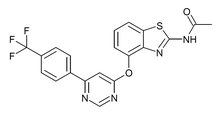

 | |
| Identifiers | |
|---|---|
| |
| CAS Number | |
| PubChem CID | |
| ChemSpider | |
| UNII | |
| ChEMBL | |
| CompTox Dashboard (EPA) | |
| Chemical and physical data | |
| Formula | C20H13F3N4O2S |
| Molar mass | 430.41 g·mol−1 |
| 3D model (JSmol) | |
| |
| |
AMG-517 is a drug which acts as a potent and selective blocker of the TRPV1 ion channel.[1][2] It was developed as a potential treatment for chronic pain, but while it was an effective analgesic in animal studies it was dropped from human clinical trials at Phase I due to producing hyperthermia as a side effect, as well as poor water solubility. It is still used in scientific research into the function of the TRPV1 channel and its role in pain and inflammation, and has been used as a template for the design of several newer analogues which have improved properties.[3][4][5][6][7]
This pharmacology-related article is a stub. You can help Wikipedia by expanding it. |